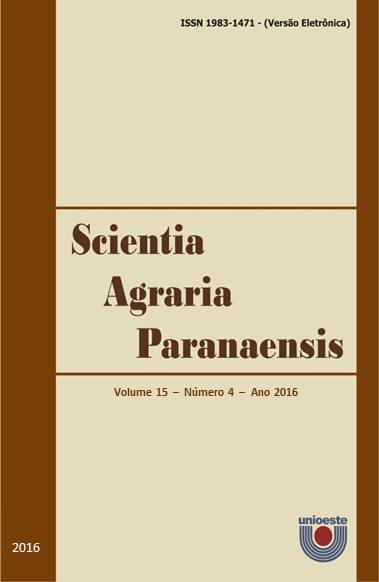Estímulo do potencial germinativo e fisiológico de centeio e triticale por Azospirillum brasilense, submetidos ao tratamento químico de sementes
DOI:
https://doi.org/10.18188/sap.v15i4.13329Palavras-chave:
bactérias diazotróficas, fisiologia de semente, Secale cereale, xTriticosecale [Secale x Triticum].Resumo
O presente trabalho objetivou avaliar os efeitos da interação da inoculação de Azospirillum brasilense com os fungicidas captana e carboxina + tiram, utilizados no tratamento de sementes, sobre o desenvolvimento inicial de centeio e triticale. O estudo em dois experimentos simultâneos foi desenvolvido na Universidade Federal da Fronteira Sul, campus Laranjeiras do Sul, PR. O delineamento adotado foi inteiramente casualizado, com oito tratamentos e quatro repetições. Os tratamentos utilizados foram: testemunha; inoculante Azospirilum brasiliense; fungicida captana; fungicida carboxina + tiram; captana + carboxina + tiram; A. brasiliense + captana; A. brasiliense + carboxina + tiram; A. brasiliense + captana + carboxina + tiram. Foram avaliados o teste de germinação (4º, 7º/8º DAS) e parâmetros morfométricos (número de raízes; comprimento de raiz, parte aérea e total; massas verde e seca total). Para cultura do centeio, A. brasiliense demonstrou interação sinérgica com captana para o comprimento da raiz, ao passo que para germinação inicial e comprimento da parte aérea os maiores valores foram observados com o uso isolado da bactéria. Carboxina + tiram proporcionou menor valor para comprimento de parte aérea e comprimento de raiz. Para triticale, a bactéria apresentou interação sinérgica com carboxina + tiram para comprimento de parte aéreas, mas, para as variáveis germinação final, comprimento total de planta e comprimento e número de raízes, os maiores valores foram obtidos com o uso isolado de A. brasiliense, onde a presença de ambos fungicidas resultaram em menor incremento. Os fungicidas e a bactéria A. brasiliense interferem na germinação e no desenvolvimento de centeio e triticale.
Downloads
Publicado
Como Citar
Edição
Seção
Licença
Aviso de Direito Autoral Creative Commons
Política para Periódicos de Acesso Livre
Autores que publicam nesta revista concordam com os seguintes termos:
1. Autores mantém os direitos autorais e concedem à revista o direito de primeira publicação, com o trabalho simultaneamente licenciado sob a Licença Creative Commons Attribution que permite o compartilhamento do trabalho com reconhecimento da autoria e publicação inicial nesta revista.2. Autores têm autorização para assumir contratos adicionais separadamente, para distribuição não-exclusiva da versão do trabalho publicada nesta revista (ex.: publicar em repositório institucional ou como capítulo de livro), com reconhecimento de autoria e publicação inicial nesta revista.
3. Autores têm permissão e são estimulados a publicar e distribuir seu trabalho online (ex.: em repositórios institucionais ou na sua página pessoal) a qualquer ponto antes ou durante o processo editorial, já que isso pode gerar alterações produtivas, bem como aumentar o impacto e a citação do trabalho publicado (Veja O Efeito do Acesso Livre).
Licença Creative Commons
Esta obra está licenciada com uma Licença Creative Commons Atribuição-NãoComercial-CompartilhaIgual 4.0 Internacional, o que permite compartilhar, copiar, distribuir, exibir, reproduzir, a totalidade ou partes desde que não tenha objetivo comercial e sejam citados os autores e a fonte.


